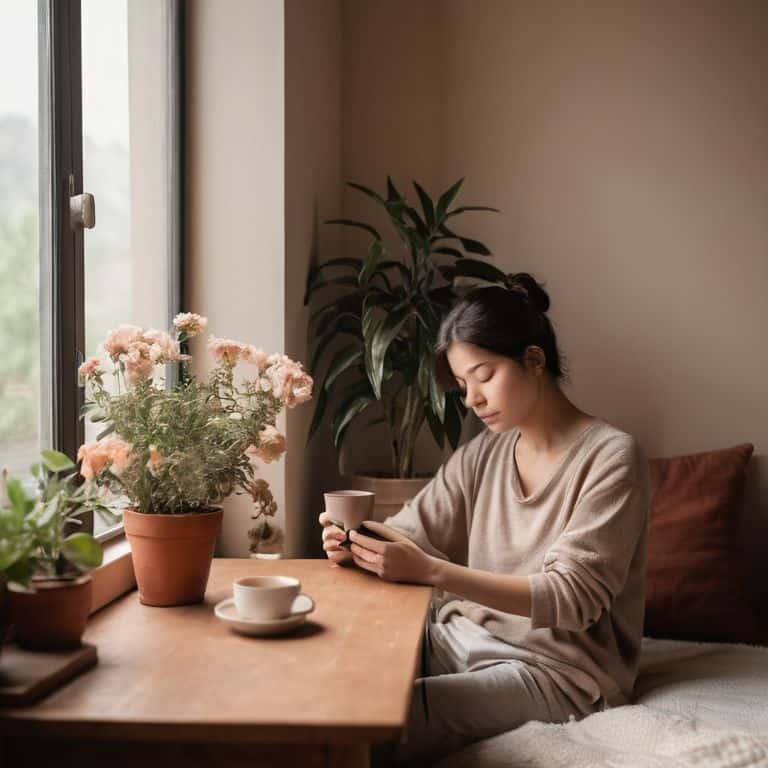I still remember the day I realized I needed to start protecting my mental health on social media. I was a digital marketer at the time, and my job required me to be constantly connected. But as I sat in front of my computer, scrolling mindlessly through my feeds, I felt a sense of drain that I couldn’t shake. It was as if the more I used social media, the more I lost myself in it. I knew I wasn’t alone in this feeling, and that’s why I want to share my story with you.
As someone who’s been in the trenches of social media burnout, I’m here to offer you a no-nonsense guide to protecting your mental health on social media. In this article, I’ll share practical, psychology-backed tips on how to use social media without losing your mind. You’ll learn how to set boundaries, prioritize self-care, and create a healthier relationship with your online presence. My goal is to provide you with actionable advice that you can start implementing today, so you can build a sustainable online presence that nourishes your mind and soul, rather than depleting it.
Table of Contents
Guide Overview: What You'll Need

Total Time: 1 hour 15 minutes
Estimated Cost: free – $10
Difficulty Level: Easy
Tools Required
- Smartphone (with social media apps installed)
- Computer (with internet access)
- Journal (for note-taking and reflection)
Supplies & Materials
- Social Media Management Apps (e.g., app blockers, website blockers)
- Mental Health Resources (e.g., online articles, support groups)
- Scheduled Downtime (e.g., set aside device-free time each day)
Step-by-Step Instructions
- 1. First, let’s start by setting boundaries around our social media use. This means deciding on specific times of the day when you will check your accounts, and sticking to those times. For me, this means checking my accounts only after my morning meditation and yoga practice, and then again after lunch. I find that this helps me avoid mindless scrolling and reduces my overall screen time.
- 2. Next, it’s essential to _curate your feed_ to ensure that the content you’re consuming is positive and uplifting. Take some time to review the accounts you’re following, and unfollow anyone who makes you feel bad about yourself or others. Instead, follow accounts that inspire and motivate you, such as wellness coaches, motivational speakers, or thought leaders in your industry.
- 3. Now, let’s talk about taking breaks from social media. This is crucial for protecting your mental health, as constant exposure to social media can lead to feelings of anxiety and burnout. I recommend taking a digital detox at least one day a week, where you avoid social media altogether. You can use this time to relax, read a book, or engage in a hobby that brings you joy.
- 4. When you do use social media, it’s essential to _practice self-compassion_. Remember that everyone presents a highlight reel of their life on social media, and it’s easy to get caught up in comparison. Instead, focus on your own strengths and accomplishments, and celebrate your unique successes. I like to remind myself that everyone has their own struggles, and that it’s okay not to be perfect.
- 5. Another critical step is to use social media intentionally. Instead of mindlessly scrolling through your feeds, use social media to achieve a specific goal, such as connecting with friends, learning something new, or promoting your business. This will help you stay focused and avoid getting sucked into the social media vortex.
- 6. It’s also important to monitor your emotions when using social media. If you find that social media is making you feel anxious, sad, or overwhelmed, it’s time to take a step back. Take a few deep breaths, and remind yourself that social media is just a tool – it’s not a reflection of your worth or identity. I like to use a mood tracker to monitor how social media is affecting my emotions, and adjust my usage accordingly.
- 7. Finally, let’s talk about creating a social media routine that works for you. This might involve setting specific times for checking your accounts, responding to comments, and posting updates. I recommend using a schedule or planner to stay organized and ensure that social media doesn’t take over your life. By creating a routine, you can use social media in a way that supports your mental health, rather than undermines it.
Protecting Your Mind Online

As I guide my clients through the process of digital wellness, I always emphasize the importance of setting boundaries on social media. This means being mindful of the time spent scrolling through feeds and taking regular breaks to relax and recharge. By doing so, individuals can avoid the pitfalls of social media addiction and cultivate a healthier relationship with their online presence. Recognizing the signs of social media addiction is crucial, as it can lead to feelings of burnout and decreased productivity.
Creating a positive online community is also vital for maintaining digital wellness. This can be achieved by surrounding oneself with like-minded individuals who promote positivity and support. I encourage my clients to engage in online forums or groups that align with their interests and values, allowing them to connect with others who share similar passions. By doing so, they can build meaningful relationships and foster a sense of belonging in the online space.
In my experience as a burnout recovery coach, I’ve seen firsthand the benefits of a social media detox. By taking a temporary break from social media, individuals can reassess their online habits and develop a more mindful approach to their digital presence. This, in turn, can lead to improved mental clarity and a reduced sense of overwhelm. By prioritizing digital wellness and being intentional with their online activities, individuals can create a healthier and more balanced online presence.
Breaking Free From Social Media Vortex
To break free from the social media vortex, I recommend scheduling regular “digital detox” days, where you avoid social media altogether. This can be as simple as taking a Sunday off from scrolling or dedicating one day a week to offline activities. I also suggest implementing website blockers or app limitations to curb mindless scrolling. By doing so, you’ll create space for more meaningful activities and reduce the constant stream of information that can be overwhelming.
By setting these boundaries, you’ll become more mindful of your social media use and begin to recognize when it’s negatively impacting your mental health. Remember, it’s about creating a healthy balance, not completely eliminating social media from your life. With time and practice, you’ll find that you’re more in control of your online interactions and better equipped to protect your mind from the potential pitfalls of social media.
Setting Boundaries for Digital Wellness
To truly protect your mind online, setting boundaries is crucial. This means being intentional about when and how you engage with social media. For me, this looks like scheduling specific times to check my accounts, and avoiding mindless scrolling throughout the day. I also make sure to prioritize non-negotiable rest time, which I color-code in my digital calendar – it’s a small act of self-care that makes a big difference.
By establishing these boundaries, you can begin to reclaim your time and energy. Start by identifying your most vulnerable moments – are you reaching for your phone out of boredom, or to avoid feelings of anxiety? Once you’re aware of your patterns, you can start to replace them with healthier habits, like taking a few deep breaths or stepping outside for some fresh air.
Nurturing Your Mental Wellbeing in the Digital Realm
- Prioritize self-compassion by scheduling social media-free days into your calendar, just as you would any other non-negotiable appointment
- Implement a ‘no-scroll’ rule during meals and at least an hour before bedtime to safeguard your mental tranquility
- Curate your feeds by unfollowing or muting accounts that trigger feelings of inadequacy, anxiety, or stress, making room for uplifting content
- Establish a daily time limit for social media engagement, using website blockers or apps to enforce this boundary and protect your focus
- Practice mindfulness while scrolling by taking periodic deep breaths, noticing your physical sensations, and reminding yourself of your intent to use social media in a way that supports your mental health
Key Takeaways for a Healthier Social Media Experience
Prioritize intentional social media use by setting clear boundaries and schedules to avoid mindless scrolling and reduce feelings of overwhelm
Implement digital wellness practices such as regular screen-free times, color-coding non-negotiable rest periods, and using website blockers to minimize distractions and increase productivity
Focus on building a supportive online community that fosters positive interactions, encourages open discussions about mental health, and promotes a culture of empathy and understanding to counterbalance the potential negative effects of social media
A Gentle Reminder
As we navigate the vast expanse of social media, remember that your mental health is not a luxury, but a necessity – and it’s okay to prioritize it, one gentle boundary at a time.
Gabriela Rossi
Embracing Digital Wellness

As we navigate the complex world of social media, it’s essential to remember that protecting your mental health is a continuous process. We’ve discussed setting boundaries, breaking free from the social media vortex, and setting healthy online habits. By implementing these strategies, you’ll be better equipped to handle the challenges of online interactions and maintain a healthier relationship with social media. It’s all about finding a balance that works for you and prioritizing your well-being in the digital age.
As you move forward, remember that small changes can add up over time. Don’t be too hard on yourself if you slip up – simply acknowledge the setback and gently get back on track. By embracing digital wellness and making conscious choices about your online presence, you’ll be taking a significant step towards a more sustainable, healthy, and fulfilling online experience. Keep in mind that your mental health is worth it, and every effort you make to protect it is a step in the right direction.
Frequently Asked Questions
How can I avoid mindless scrolling on social media without feeling like I'm missing out?
To avoid mindless scrolling, I recommend setting a “stop doing” rule: choose one platform to limit or eliminate. Replace scrolling time with a nourishing habit, like meditation or reading. This subtle shift helps you prioritize self-care and reduces FOMO, allowing you to stay focused on what truly matters.
What are some strategies for dealing with online trolls or negative comments that can affect my mental health?
For me, dealing with online trolls is about setting emotional boundaries. I prioritize self-care by limiting my engagement with negative comments, and I’ve implemented a “3-step filter” – acknowledge, assess, and accept or dismiss – to help me navigate hurtful feedback without taking it personally.
Are there any specific social media platforms or features that are more or less likely to contribute to burnout or anxiety?
Honestly, some platforms are more prone to burnout than others. I’ve found that Instagram and Twitter can be particularly draining due to their fast-paced, comparison-driven nature. Features like endless scrolling and notifications can also exacerbate anxiety. As your coach, I recommend taking a closer look at which platforms and features truly serve you, and setting boundaries accordingly.
